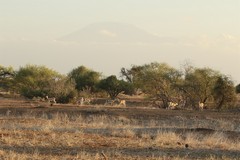
When the clouds are being kind there are
plenty of good views of Kilimanjaro from here
Selenkay is a Maasai owned conservancy about 16km north of Amboseli National Park. It is part of the same ecosystem and wildlife migrates back and forth between the two as the seasons change.
You can see its position and that of Amboseli on the Amboseli/Selenkay (map).
The Conservancy is about 60 km2 and is formed from lands leased from the much larger Eselenkei Group Ranch. The land was leased by Gamewatchers Safaris and the idea was to protect the habitat as humans are continually encroaching on the land and it is a natural wildlife dispersal area in the wet season. With nowhere for the wildlife to go the whole ecosystem would start to decline.
It was hoped that eco tourism would provide an alternative income for the local population and encourage them to protect their local wildlife. Since 1997 when the project first started there has been a large boost to the wildlife population, with some species such as elephants returning to the now 'safe' area after a hiatus of over twenty years.
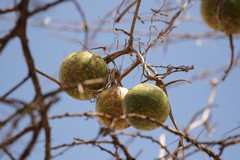
Wild melons do grow on trees. These fruits
are much sought after by elephants
There are other benefits to both locals and wildlife; since grazing is now controlled, there has been a big improvement in vegetation, which the herders can use for grazing in severe drought periods.
Rainfall is around 350mm per year, with April being the wettest month. It can vary substantially from year to year from 150mm to 550mm. There was a severe drought while we visited, but Selenkay still held a lot of green bushes which were an absolute life saver for browsers, especially the elephants.
Rainfall is bimodal. Short rains in November to December, then a lull, and then longer heavier rains from late March to May. However rainstorms can occur through January and February as well.
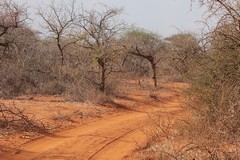
A lot of the Maasai land is red iron stained
laterite soils. In other areas the the soils are
volcanic in origin and are more of a buff colour
The area sits on Pre Cambrian basement rocks consisting of metamorphosed granitic gneisses, schists, granulites and crystalline limestones. Soils are the usual laterites, with the distinctive red colouration and lighter volcanic deposits.
Vegetation in Selenkay is mostly open areas and large tracts of mixed bush with plenty of acacias growing as well.
Since this is private land you can go off road and also do walking safaris. It was easy to walk up to large bull elephants who seemd completely untroubled by our presence,
It is the best place I've ever known for sightings of gerenuks. Normally they are very shy but here, in the thick bush areas, we saw many small herds or family units and they were very used to us being around and so allowed for great photography.
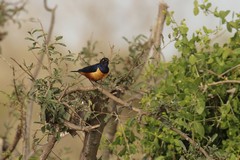
These amazingly coloured Hildebrandt's
starlings like the areas of open ground
interspersed with bush thickets. They are quite
easy to find here, although a bit shy. A good
supertelephoto lens was needed to get decent
photos and even then I needed to crop right in
Another animal that was easy to spot and photograph was the lesser-kudu, my personal favourite antelope. Again they weren't too quick to move off and there were a lot of them present.
Also there are some quite beautiful birds. The absolute best was the Hildebrandt's starling; even prettier than the superb starlings which were also present in large numbers. And around camp there were lots and lots of go-away birds.
The beauty of the conservancy is that it is private, and so access is stricltly limited to vehicles from the single camp. So basically we didn't see any other vehicles at sightings. It is a much nicer experience than being crowded around sightings in Amboseli. However as a change you can drive down to Amboseli for a full day trip, which is a sensible thing to do. The drive down through the Maasai land takes about an hour and a half, since the tracks are not great, and there is wildlife to be spotted all the way down, We saw many herds of Grant's gazelles like this. There were also several good views of Kilimanjaro when the sky was clear enough.
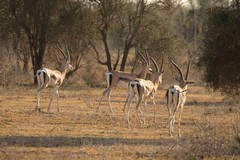
You never know what's in the next clearing.
In this case a small batchelor herd of
Grant's gazelles
Some other species that can be seen here are eland, oryx, striped hyaena, Grant's and Thompson's gazelles, ostriches, warthogs, cheetah and African wildcat.
There is a long and complex relationship between the Maasai herdsmen and lions. They have co-existed for hundreds of years, but now encroachment on the lions territory and the simultaneous loss of prey species is causing more and more human wildlife conflict.
This is where the Lion Guardians organisation was founded, to help mitigate problems with lions and protect lions. The Lion Guardians have been very successful by using practical measures to help both lions and herds of livestock to co-exist. In this area over 300 homesteads are reinforced each year, Over USD 2 million worth of potential livestock losses annually is avoided. The Guardians monitor and track the problem lions and warn villagers of their presence. They prevent around 50 lion hunts a year. As a result lion numbers are recovering slowly in the area.
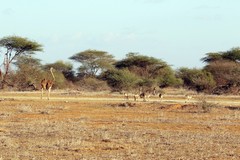
Ostriches were very common all over the
conservancy where there were open areas
Some of the problems facing the Conservancy include, long term increases in temperature and decrease in rainfall for the area, brought about by climate change.
At least bushmeat poaching isn't a big problem as the wildlife has value to the community. Snares are few and far between as it's not in anyone's interest to take the game. It's the tourism income that lets everyone benefit.
Selenkay is a rather different sort of area to visit in Kenya, because of its large areas of thick bush. Consequently some less often seen species are present. It is also very quiet in terms of human traffic.
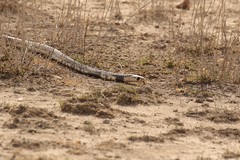
This Egyptian cobra was seen on the drive
down to Amboseli from Selenkay.
Unfortunately it didn't want to show us its hood
I found the area to be a pleasure to drive around as I never knew what I'd see next, and it was really good for photography. It has a very diverse birdlife. It complements a stay in Amboseli very well.
One final comment: Sir David Attenborough stayed in Selenkay while filming for his 'Africa' series in 2013. So it must be good.